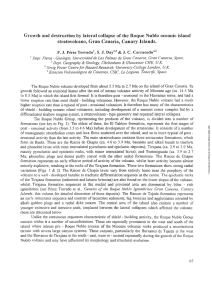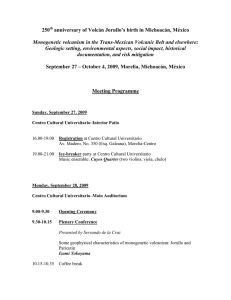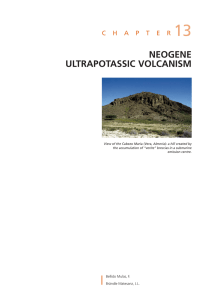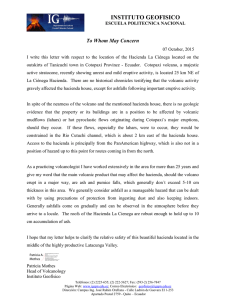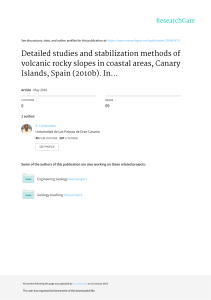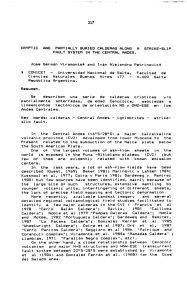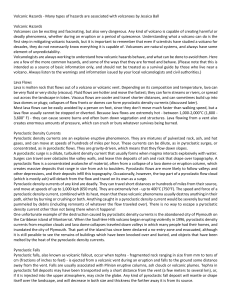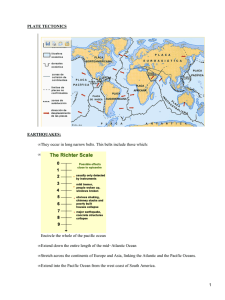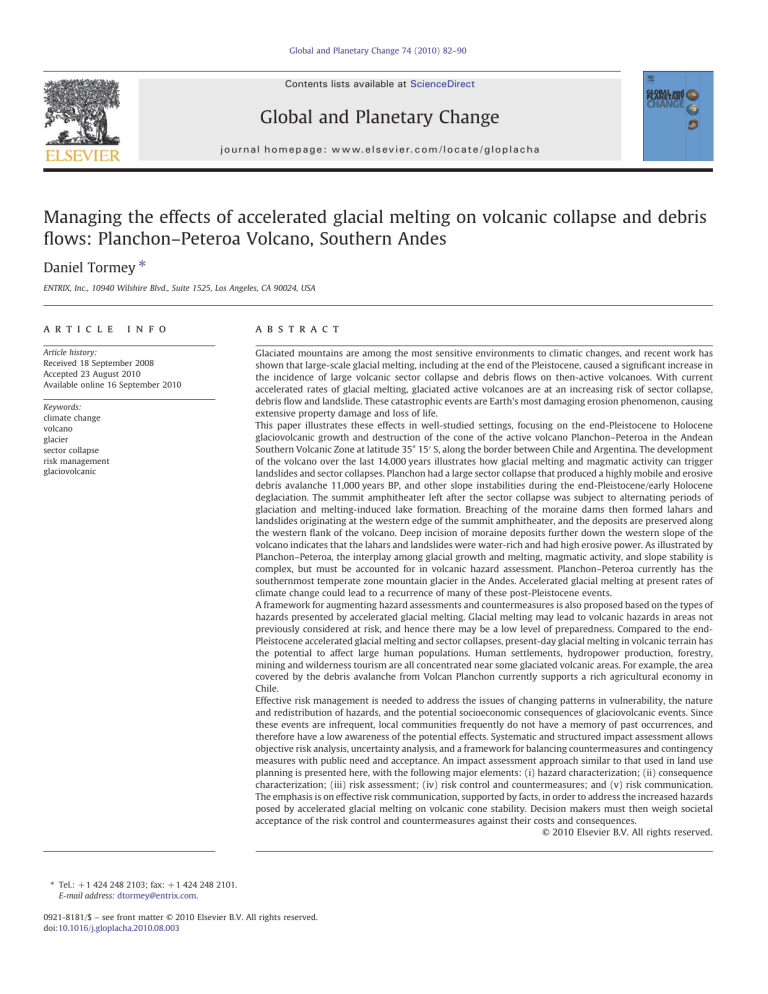
Global and Planetary Change 74 (2010) 82–90 Contents lists available at ScienceDirect Global and Planetary Change j o u r n a l h o m e p a g e : w w w. e l s ev i e r. c o m / l o c a t e / g l o p l a c h a Managing the effects of accelerated glacial melting on volcanic collapse and debris flows: Planchon–Peteroa Volcano, Southern Andes Daniel Tormey ⁎ ENTRIX, Inc., 10940 Wilshire Blvd., Suite 1525, Los Angeles, CA 90024, USA a r t i c l e i n f o Article history: Received 18 September 2008 Accepted 23 August 2010 Available online 16 September 2010 Keywords: climate change volcano glacier sector collapse risk management glaciovolcanic a b s t r a c t Glaciated mountains are among the most sensitive environments to climatic changes, and recent work has shown that large-scale glacial melting, including at the end of the Pleistocene, caused a significant increase in the incidence of large volcanic sector collapse and debris flows on then-active volcanoes. With current accelerated rates of glacial melting, glaciated active volcanoes are at an increasing risk of sector collapse, debris flow and landslide. These catastrophic events are Earth's most damaging erosion phenomenon, causing extensive property damage and loss of life. This paper illustrates these effects in well-studied settings, focusing on the end-Pleistocene to Holocene glaciovolcanic growth and destruction of the cone of the active volcano Planchon–Peteroa in the Andean Southern Volcanic Zone at latitude 35° 15′ S, along the border between Chile and Argentina. The development of the volcano over the last 14,000 years illustrates how glacial melting and magmatic activity can trigger landslides and sector collapses. Planchon had a large sector collapse that produced a highly mobile and erosive debris avalanche 11,000 years BP, and other slope instabilities during the end-Pleistocene/early Holocene deglaciation. The summit amphitheater left after the sector collapse was subject to alternating periods of glaciation and melting-induced lake formation. Breaching of the moraine dams then formed lahars and landslides originating at the western edge of the summit amphitheater, and the deposits are preserved along the western flank of the volcano. Deep incision of moraine deposits further down the western slope of the volcano indicates that the lahars and landslides were water-rich and had high erosive power. As illustrated by Planchon–Peteroa, the interplay among glacial growth and melting, magmatic activity, and slope stability is complex, but must be accounted for in volcanic hazard assessment. Planchon–Peteroa currently has the southernmost temperate zone mountain glacier in the Andes. Accelerated glacial melting at present rates of climate change could lead to a recurrence of many of these post-Pleistocene events. A framework for augmenting hazard assessments and countermeasures is also proposed based on the types of hazards presented by accelerated glacial melting. Glacial melting may lead to volcanic hazards in areas not previously considered at risk, and hence there may be a low level of preparedness. Compared to the endPleistocene accelerated glacial melting and sector collapses, present-day glacial melting in volcanic terrain has the potential to affect large human populations. Human settlements, hydropower production, forestry, mining and wilderness tourism are all concentrated near some glaciated volcanic areas. For example, the area covered by the debris avalanche from Volcan Planchon currently supports a rich agricultural economy in Chile. Effective risk management is needed to address the issues of changing patterns in vulnerability, the nature and redistribution of hazards, and the potential socioeconomic consequences of glaciovolcanic events. Since these events are infrequent, local communities frequently do not have a memory of past occurrences, and therefore have a low awareness of the potential effects. Systematic and structured impact assessment allows objective risk analysis, uncertainty analysis, and a framework for balancing countermeasures and contingency measures with public need and acceptance. An impact assessment approach similar to that used in land use planning is presented here, with the following major elements: (i) hazard characterization; (ii) consequence characterization; (iii) risk assessment; (iv) risk control and countermeasures; and (v) risk communication. The emphasis is on effective risk communication, supported by facts, in order to address the increased hazards posed by accelerated glacial melting on volcanic cone stability. Decision makers must then weigh societal acceptance of the risk control and countermeasures against their costs and consequences. © 2010 Elsevier B.V. All rights reserved. ⁎ Tel.: + 1 424 248 2103; fax: + 1 424 248 2101. E-mail address: [email protected]. 0921-8181/$ – see front matter © 2010 Elsevier B.V. All rights reserved. doi:10.1016/j.gloplacha.2010.08.003 D. Tormey / Global and Planetary Change 74 (2010) 82–90 1. Introduction Volcanic terrain exhibits Earth's highest rates of topographic change (McGuire et al., 1990). Slopes of active volcanoes are typically over steepened, deposits can be hydrothermally altered and weakened, and the cones are frequently near their stability limit (Scott et al., 2001; Tibaldi et al., 2008). Volcanic sector collapse, landslides, and lahars that result from these conditions are among the most damaging erosion phenomenon, since they are large and occur rapidly, and they can cause extensive property damage and loss of life (Sidle and Ochiai, 2007). Glaciated volcanoes have the additional destabilizing factor of debuttressing and increased sediment pore pressures caused by glacial melting; they therefore constitute an ideal environment for debris flow formation. The 1985 eruption of Nevado del Ruiz volcano in Colombia rapidly melted snow and glacial ice, which triggered two large lahars that swept down different slopes of the volcano into valleys, killing about 20,000 people in Armero and about 1800 people in Chinchina (Pierson et al., 1990; Mileti et al., 1985; Voight, 1996). Glaciated mountains in temperate to tropical latitudes are recognized as among the most sensitive environments to climatic changes, illustrated by the current warming trend (Brecher and Thompson, 1993; IPPC, 2007). Glacial-related debris flows are increasingly common in the Alps (Chiarle et al., 2007), which have lost about half their ice volume since the mid 19th century, as well as a reduction in permafrost area (Haberli and Beniston, 1998). Glacial thinning and retreat in western Canada associated with climate warming during the last 100 years triggered landslides due to debuttressing effects and there was an increase in outburst floods and debris flows initiated from moraine and ice dammed lakes (Evans and Clague, 1994). Several studies have shown reductions in the volume and extent of glaciers in the Andes, Himalayas, Alps, and Rocky Mountains (Solomina et al., 2008; Ramirez et al., 2001; Hastenrath and Ames, 1995). Ice avalanches, emptying of glacial lakes and water bodies, and glacial surges occur as part of glacial advance and retreat. The annual accumulation and ablation cycles and precipitation are affected by a warming climate. Masiokas et al. (2008) document glacial recession and reduced precipitation in the Patagonian Andes, in the vicinity of the study area. The overall pattern illustrated by recent studies is one of glaciers more out of equilibrium with climate, with many on the verge of lake formation or disappearance (Benn and Wiseman, 2001). A recent compilation of climate forcing factors on glacial stability over the last 10,000 years indicates that ice front movements tend to lag 10 to 20 years behind temperature changes (Grove, 2008). Capra (2005) presents data from volcanic collapse over the last 30,000 years indicating that periods of regional-scale glacial melting correspond to a significant increase in the incidence of sector collapse and debris flows on then-active volcanoes. The data indicate volcanic collapse events occurring just after glacial maxima. With present-day increased rates of glacial melting, active volcanoes in tropical and temperate latitudes are currently at an increased risk of landslides, lahars, and sector collapse. In addition, the increased rates of melting can trigger hydromagmatic events, which can in turn lead to increased landslide risk. An interplay is established between glacial melting, magmatic activity, and sector collapse. Glacial retreat can have several effects on landslide and debris flow formation on volcano slopes. Retreat debuttresses the slope, thus leaving it in a more unstable state. As glaciers melt, the released water infiltrates and increases sediment pore pressures, which can cause slope failure. In particular, if an impermeable layer is encountered during infiltration, a shallow water saturated zone can accumulate, further weakening the slopes. The permeability of volcanic cones in extremely heterogeneous, with impermeable lavas alternating with highly permeable ash and cinder deposits, and hydrothermal alteration that can lead to low friction properties similar to a quick 83 clay (Iverson, 1997). Alternating layers of permeable and low permeability volcanic materials allow meltwater to accumulate and pore pressures to increase, at times to slope failure. Predictions of volcanic slope stability and delineation of volcanic hazard zones will have to account for the accelerated rate of glacial retreat and the consequent effects on volcano stability. More frequent and intense rain events have also been observed to combine with glacial melting to induce slope failure, landslides, and debris flows in the Alps (Chiarle et al., 2007). In addition to accelerated glacial melting inducing sector landslides and sector collapse, the 1980 sector collapse and eruption of Mt. St. Helens in Washington, USA, illustrates that magmatic events trigger sector collapse. During the 1980 eruption of Mt. St. Helens, rapidly melting snow and ice triggered two large lahars, which traveled 27 km from the crater and eroded recent pumice flow deposits (Pierson and Scott, 1985). Past sector collapses covered large areas of now densely populated regions (Scott et al., 2001 and references therein). Many of these collapse events were triggered by glacial melting, or by the combination of glacial melting and volcanic activity. Glacial melting on an active volcano can also increase the incidence of phreatomagmatic events. Present-day acceleration of deglaciation rates therefore increases glaciovolcanic risk. Studies of individual volcanic centers that were subject to endPleistocene deglaciation and sector collapse can elucidate the interactions between accelerated glacial melting, slope instability, and magmatic activity, including mechanisms and consequences. Studies of this past period of accelerated glacial melting and volcano instability in turn support improved hazard assessment and countermeasure strategies at currently active volcanoes with summit glaciers. This paper illustrates these effects by describing the growth and destruction over the last 14,000 years of the glaciated cone of the active volcano Planchon–Peteroa in the Andean Southern Volcanic Zone at latitude 35° 15′ S, along the border between Chile and Argentina (Fig. 1). This volcano had a large sector collapse related to end-Pleistocene deglaciation that produced a highly mobile and erosive debris avalanche 11,000 years BP, and other slope instabilities followed during the end-Pleistocene/early Holocene deglaciation (Tormey et al., 1995), as in other parts of the Andes (Mark, 2008; Moreiras, 2008; Masiokas et al., 2008). The development of the volcano also illustrates how magmatic activity can trigger collapses, and how collapses induce changes to the location and type of volcanic activity. The interplay among glaciovolcanic factors is complex, but must be taken in to consideration in the assessment of volcanic hazards. A framework is also proposed for hazard assessment and countermeasures that can be applied to glaciated volcanoes that may be subject to these types of glaciovolcanic hazards. 2. Glacial activity, sector collapse, and magmatic variation at Planchon–Peteroa Volcano, Southern Chilean Andes The active volcanic complex of Azufre, Planchon, and Peteroa is located in remote, steeply glaciated terrain on the crest of the Andes at 35° 15′ S. Dissection by glaciers and sector collapse provide spectacular exposure of this still-active volcanic system, and allows study of stratigraphic sections and collection of samples with known relative age (Tormey et al., 1989, 1995; Naranjo and Haller, 2002). Pleistocene-Holocene volcanic rocks at this center have been divided into five major volcano-stratigraphic units primarily based on field relations, supported by petrographic and geochemical criteria (Tormey et al., 1989, 1995; Naranjo and Haller, 2002). These units, from oldest to youngest, are named Volcan Azufre, Volcan Planchon, Rio Teno Debris Avalanche, Volcan Planchon II, and Volcan Peteroa (Fig. 2). Basement rocks underlying this succession consist of Cretaceous marine sediments (Davidson, 1974; Tormey et al., 1995), overlain by a voluminous section of Tertiary lavas ranging in composition from basalt to rhyolite (Haller et al., 1985; Llambias 84 D. Tormey / Global and Planetary Change 74 (2010) 82–90 Fig. 1. Regional location map along the Andes from 32° to 36° S. Grey areas depict present-day extent of mountain glaciers in this portion of the Andes, corresponding approximately to the 3700 m contour. Volcan Planchon–Peteroa is the southernmost mountain glacier in this segment of the Andes. and Rapela, 1987). The basement succession has been variably folded, and is cut by mid-Tertiary granodiorite plutons (Tormey et al., 1995). The volcanic complex is less than 0.55 my (Tormey et al., 1995), and consists of the long-lived polycyclic basaltic andesite to dacite Volcan Azufre (69 km3), followed by the relatively short-lived basalt to basaltic andesite Volcan Planchon, which began activity approximately 14,000 years BP (Naranjo and Haller, 2002). Between 14,000 and 11,000 years BP, the Planchon cone was built up rapidly to 43 km3, developed a shallow-level magma system, and was then eviscerated by a sector collapse at 11,000 years BP that produced the 10 km3 Rio Teno Debris Avalanche (MacPhail, 1973). The highly mobile Rio Teno Debris Avalanche entrained alluvial material during flow, and traveled at least 95 km to debouch into Chile's central valley in a location that today supports part of Chile's wine district and other agricultural industries. Post-sector collapse magmatic activity then migrated 1 km south creating the 5 km3 edifice of Volcan Planchon II. Five Holocene volcanic craters known collectively as Volcan Peteroa are located within the summit amphitheatre formed by the sector collapse (Tormey et al., 1995; Naranjo and Haller, 2002), and are aligned along the north–south Planchon–Azufre axis (Fig. 2). Basement structure controls the orientation of volcanic features. The volcanic front near Planchon–Peteroa was developed in a compressional stress regime as part of the Mallargue fold and thrust belt from Miocene to Pliocene (Ramos et al., 1996; Hildreth et al., 1999). The basement structures are dominated by reverse faults striking approximately north–south. Folguera et al. (2006) have identified a series of Pliocene to Quaternary back-arc extensional basins that, in the vicinity of Planchon–Peteroa, comprise the Las Loicas trough. This feature intersects the volcanic front and appears to be partially filled by eruptive products from the active Planchon– Peteroa volcanic complex. As such, much of the development of the volcanic complex is likely to have been in a neutral state of stress in the crust, transitional from compression to extension (Hildreth et al., 1999; Kay et al., 2005; Folguera et al., 2006). 2.1. Rio Teno Debris Avalanche The 43 km3 Planchon cone grew rapidly over the course of 4,000 years (Naranjo and Haller, 2002). Planchon's lavas are sheetlike and do not fill obvious topographic features, and there are no intercalations of sediment within the flow succession. It appears, therefore, that flows were not channelized, the growth of the volcano was not interrupted by glaciation, and the construction of Planchon was rapid enough to prevent deep erosion during growth. This rapid rate of growth led to an inherently unstable volcanic edifice, perhaps stabilized by the presence of a summit glacier. During the late Pleistocene deglaciation, a 30° sector of the rapidly constructed Planchon cone collapsed and generated the Rio Teno Debris Avalanche. The debris avalanche traveled 95 km towards the northwest down the Rio Claro and Rio Teno watersheds, finally debouching into the Central Valley where it forms a hummocky deposit (Fig. 3) approximately 10 km3 in volume and covering at least 370 km2 (MacPhail, 1973; Davidson, 1974; Naranjo et al., 1997). The major axis of the collapse sector is approximately north–south, along the dominant direction of regional faulting (Folguera et al., 2006); the summit amphitheater resulting from the sector collapse faces west. In a study of the geology and geochemistry of this volcanic center, Tormey et al. (1995) documented that most basalt and basaltic D. Tormey / Global and Planetary Change 74 (2010) 82–90 85 Fig. 2. Geological map of the Azufre–Planchon–Peteroa volcanic center. The extent of the current mountain glacier is shown in grey. Morraines indicate the extent of earlier glaciers. Fig. 3. Satellite image showing Planchon and Azufre (circled on right side of image), and west to the Chilean central valley. Black arrows show the path of the Rio Teno Debris Avalanche from Volcan Planchon down the Rio Claro and Rio Teno drainages, to the black outline showing the approximate extent of the deposit, 95 km from the volcanic source area. The flow bulked up from 3 km3 to 10 km3 during transport through these watersheds. White arrows show the possible path of a comparable debris avalanche that may be sourced at the currently glaciated Azufre summit. 86 D. Tormey / Global and Planetary Change 74 (2010) 82–90 andesite lavas erupted from Planchon volcano evolved at mid-crustal depths of approximately 12 to 18 km depth. Just prior to the Rio Teno Debris Avalanche, however, a series of basaltic andesite lava flows indicate shallow-level fractional crystallization and assimilation of shallow crustal wall rocks. Although the depth cannot be constrained with certainty because a lower water pressure would give a similar compositional trend, it is likely to be within the upper 3 km of the crust (Tormey et al., 1995). The temporary development of a shallow magma body may have ultimately facilitated the debris avalanche, either through enhanced hydrothermal activity, melting of the summit ice cap, or minor eruption. The Rio Teno Debris Avalanche deposit is primarily located in Chile's Central Valley, preserves at least two distinct lobes of flow, and shows grain-size gradation laterally and longitudinally (MacPhail, 1973; Tormey et al., 1989). The two lobes can be traced along the surface of high river terraces to the confluence of the Rio Teno and Rio Claro (MacPhail, 1973). The lateral fasces of the deposit have 30% to 50% of large mounds or hummocks; these hummocks are formed by megaclasts in the deposit (Scott et al., 2001). The matrix is fine grained (silts and fine sands with approximately 10% clay) and preserves the slurry of the debris flow (MacPhail, 1973); Vallance (1997) refers to this as a cohesive debris flow, which remains a coherent debris flow to its terminus. A significant fraction of the deposit contains material entrained during flow, although the finegrained matrix also contains a contribution from cataclasis of basalt megaclasts derived from the edifice (Scott et al., 2001). Clearly juvenile magmatic components, such as prismatically jointed clasts, are relatively rare, suggesting that the collapse was not accompanied by a large eruption (Naranjo et al., 1997). The ratio of fall height and runout distance (H/L) has been called the equivalent coefficient of friction (Shreve, 1968; Iverson, 1997) and has become a common measure of the mobility of debris avalanches. With a fall height of 3,700 m and a runout distance of 95 km, the Rio Teno Debris Avalanche's H/L of 0.03 corresponds to exceptionally high mobility. The debris avalanche transformed to a more mobile debris flow due to the high amount of water entrainment (Scott et al., 2001); the traditional name for the deposit is retained; however, its behavior and the resulting deposit clearly indicate that it was a debris flow. Such a long runout distance requires substantial amounts of water to provide the power for flow. Melting of the mountain glacier and the glacial material that was further down the valley of the U-shaped Rio Claro during the end of the Pleistocene were the likely sources of this large amount of water. Intense rainfall was unlikely to provide sufficient water (MacPhail, 1973). In the distance between the volcano and the deposit, the debris flow was highly erosive in the Rio Claro and Rio Teno stream corridors. Based on the area excavated by the sector collapse, a volume of approximately 4 to 5 km3 of material was derived from the volcanic edifice while the remainder appears to have been entrained during flow. Bulking of the flow from material in the river valleys approximately doubled the volume of material that ultimately deposited. Owing to the highly erosive flow, there are no known deposits in the Rio Claro watershed. The mechanics of entrainment of bed material by a sediment-rich debris flow is not well understood; the presence of the megaclasts in the flow may enhance entrainment of alluvial bed material. In order to maintain flow and inhibit deposition, the entrained material had to be sufficiently wet to maintain pore pressures and sediment transport (Iverson, 1997). Iverson (1997) notes that the head of the flow typically acts as a break on the debris flow. There are two lobes evident in the debris flow deposit, indicating that additional wet material from the cone was required to overcome the stalling of the initial flow, and to lead to the extensive deposit now evident in the Chilean central valley. Substantial amounts of water from melting of the glacial material are the most likely source of the water needed to power the flow; intense rainfall was likely insufficient (MacPhail, 1973). Capra (2005) noted an increased incidence of sector collapse deposits at the end-Pleistocene glacial melting. This observation further supports the conclusion that substantial melting of the summit ice cap was an essential factor in the size and mobility of the debris flow. 2.2. Post-sector collapse activity A new edifice, Planchon II, grew 1 km south of Planchon, within the summit amphitheater left by the Rio Teno Debris Avalanche sector collapse (Fig. 2). Similar post-collapse migration of eruptive location towards the sector collapse is also observed at Stromboli Volcano and may represent migration towards a zone of lower lithostatic pressure after summit evisceration (Tibaldi, 2003). The Planchon II edifice was rapidly dissected, but its outlines are preserved as ramparts of radially dipping lavas. Planchon II had a larger proportion of near-vent pyroclastic deposits than Planchon; this additional structural weakness may have contributed to the rapid self-destruction of the cone by lahars and landslides (Tibaldi, 2001; Apuani et al., 2004). Volcanic landslides typically occur in loose, recently deposited ash, volcanic ejecta, and pyroclastic debris on over steepened slopes and are triggered by rainstorms, melting of snow and ice, eruption, or release of water from crater lakes, the latter three of which often occur near the summit of volcanoes (Iverson, 1997). Additionally, materials along the flanks of volcanoes are internally weakened by hydrothermal fluids and alteration, which gives the material the characteristics of clay with less frictional support. Volcanic sediments with high porosity and low cohesion can experience dynamic shearing during conditions of high fluid pressure and sudden triggering by seismic or eruptive activity. Following such loading, dynamic shearing fluidization occurs due to the excess pore pressure (Iverson et al., 1997; Ochiai et al., 2004). This behavior is well illustrated in the Holocene history of Planchon II, which occurred during a period of warming and glacial melting. Lahars and landslides appear to have been initiated repeatedly by breaching of moraines at the western edge of the summit amphitheater (Fig. 2), and the deposits are preserved along the western flank of the volcano (Naranjo and Haller, 2002). It is likely that the summit amphitheater was subject to alternating periods of glaciation and melting-induced lake formation. Breaching of the moraine dams then formed the lahars. Deep incision of moraine deposits further down the western slope of the volcano indicates that the lahars had high erosive power near the steep flanks of the volcanic edifice. The frequency of landslide events over the period from 11,000 to 7000 years BP was not seen in the earlier history of Planchon, further indicating the action of glacial melting and permafrost thawing inducing the slope instability (Naranjo and Haller, 2002). After the Rio Teno Debris Avalanche, the composition of basalt and basaltic andesite lavas erupted from Planchon II reverted to those indicative of mid-crustal (12 to 18 km depth) evolution; lavas of Planchon II are compositionally indistinguishable from the early lavas of Planchon (Tormey et al., 1995). It is not clear whether the sector collapse caused the cessation of shallow-level magma storage, but the post-collapse lavas clearly erupted without the imprint of shallowlevel crystallization and crustal assimilation (Tormey et al., 1995). The most recent activity of the volcanic complex produced Volcan Peteroa, which encompasses five vents along the north–south axis of Azufre and Planchon. The eruptions and deposits attributed to Peteroa are highly dependent on the presence of an extensive glacier that built within the summit amphitheater left from the Rio Teno Debris Avalanche and the destruction of the Planchon cone. The amphitheater is 3 km in diameter (Fig. 3), and contained a glacier with an estimated volume of ice between 0.04 and 0.06 km3 (Naranjo and Haller, 2002). In addition to the role played by melting glaciers on sector collapse and more frequent lahar and landslide initiation, glaciovolcanic interaction can change the character and intensity of magmatic D. Tormey / Global and Planetary Change 74 (2010) 82–90 events. The first recognized Holocene eruption from Volcan Peteroa, which followed the activity of Planchon II, was dated at 7000 years BP (Naranjo and Haller, 2002) and consisted of a water-rich sequence that developed from an initial, short-lived tephra-fall, followed by a pyroclastic surge with water magma ratio approximately 50:50, followed by a scoria-rich pyroclastic flow (Naranjo and Haller, 2002). The magmatic deposits are located to the east of the volcano, consistent with the predominant wind direction in the area. The eruption also included lahars, but these deposits are found to the west of the volcano, in the direction of the opening of the summit amphitheater and along the principal watersheds. For the first time in 15,000 years of activity we see preserved in the stratigraphic record a more explosive character to magmatic events, and mineralogical evidence for greater water content. In addition to mediating lahar and landslide formation, the summit glacier affects the character of recent eruptions. Tormey et al. (1995) demonstrated that the pre-collapse system (Azufre, Planchon) was predominantly a tholeiitic basalt-dacite lava series, while post-collapse the system evolved from this tholeiitic activity (Planchon II) to a calcalkaline system consisting of mixed andesites, dacites, and rhyodacites (Peteroa). The post-collapse material from Peteroa results from more explosive events, reaches more silicic compositions (rhyodacite), and has micro and macro-textures indicative of magma mixing (Tormey et al., 1995). Peteroa magmas have developed at shallow crustal levels (Tormey et al., 1995), indicating a shallow-level heat source to promote glacial melting. In 1991 and again in 1998 there were predominantly phreatomagmatic eruptions, likely triggered by the increased water infiltration from the melting summit glacier. The Holocene activity of Volcan Peteroa illustrates the interplay between magmatic activity and a summit glacier. The history of the Planchon–Peteroa volcanic center over the last 14,000 years demonstrates that a wide variety of glaciovolcanic phenomena occurred, starting with the large sector collapse during the climate change-induced melting of the mountain glacier starting at 11,000 years BP, and continuing in the Holocene with the interplay between active volcano and summit glacier. The next section considers how this knowledge derived from the last warming period can assist planning for and adapting to the current warming period. 3. Future hazards at Volcan Planchon–Peteroa and other volcanoes in glacial terrain Volcanic debris flows and lahars travel rapidly downslope and through channel systems, inflicting widespread damage because of their size and unexpected nature (Sidle and Ochiai, 2007). Indeed, the large volumes associated with volcanic landslides (particularly flank collapses and sector collapses) and lahars, together with their rapid velocity and temporal unpredictability, make these the most hazardous slope failure event in terms of loss of human life and property damage (Sidle and Ochiai, 2007). The interplay between glacial melting and the growth and destruction of Volcan Planchon–Peteroa is likely to be typical for glaciated temperate zone and tropical volcanoes. However, there are few well-studied volcanic centers in glacial terrain that were subject to end-Pleistocene deglaciation and sector collapse, followed by strong coupling between magmatic activity, glacial melting, and hazards. Study of the effects of the past period of accelerated glacial melting and volcano instability supports improved hazard assessment and countermeasure strategies at currently active volcanoes with summit glaciers during the current period of accelerated glacial melting. Rock glaciers in the Andes south of Santiago, Chile, occupy approximately 10% of the total land surface between 3,500 and 4,250 m elevation, with an estimated water equivalent of 0.3 km3 per 1000 km2 of mountain area (Fig. 1); this value is one order of magnitude higher than in the Swiss Alps (Brenning, 2005). Climate data indicate 87 that the lowest elevation occurrences of active rock glaciers in this region of the Andes of Santiago are not in equilibrium with modern climate. Active temperate-zone rock glaciers are absent south of Volcan Planchon–Peteroa at 35° 15′ S due to lower topography, active volcanism and increased humidity (Brenning, 2005). A warming climate, as has been demonstrated in this portion of the Andes by Masiokas et al. (2008), has a number of potential consequences for glaciovolcanic hazards, as illustrated by the history of Planchon–Peteroa. Ballantyne (2002) describes these as paraglacial responses to warming, in which deglaciation results in the exposure of unstable sediment sources that are subsequently mobilized by a variety of processes over a variety of timescales. The paraglacial context is a useful one to understand these effects. The formation and disappearance of ice- and moraine-dammed lakes are often associated with changes in glacial extent (Haberli and Beniston, 1998). Debris flows are also a well-recorded consequence of glacier retreat (Ballantyne and Benn, 1994). Existing moraine-dams may experience accelerated degradation through melting of ice cores (Richardson and Reynolds, 2000) and their lakes may increase in volume due to greater melt water input (Clague and Evans, 2000). Many mountain glaciers exist close to the melting point (Thompson, 1980), including the Planchon glacier (Brenning, 2005), and even a modest increase in temperature may have substantial effects on slope stability of these inherently unstable edifices. Planchon–Peteroa is the southernmost temperate zone glacier in the Andes. As such, it is likely to be the first of the Andean rock glaciers to be lost as climate continues to warm and dry. The history of the growth and destruction of the center spanned the late Pleistocene glacial melting, and its subsequent history has depicted the importance of glacial conditions to the incidence of landslides, lahars, and large-scale sector collapse. All of these conditions are still in place, and as such melting of the current glacier increases the hazard posed by this active volcano. Since Planchon experienced a large sector collapse and the cone has not yet rebuilt, the risk of another large collapse from the northern flank of the volcano is unlikely (Iverson, 1997). However, the southern flank of the summit amphitheater is still a substantial edifice (Volcan Azufre), and unlike the basalts of Planchon, the southern rampart and edifice consists of deposits from a polycyclic composite volcano and as such contains a higher proportion of porous pyroclastics and extensive hydrothermal alteration (Tormey et al., 1995). Hydrothermal alteration can weaken the rock materials, making them more prone to failure (Vallance, 1997). Reid et al. (2001) used three-dimensional slope stability analysis of Mount Rainier and its summit glacier, mapped distributions of strong (fresh) and weak (altered) rock, and found that flank collapse was promoted by voluminous, weak, hydrothermally altered rock located high on steep slopes. Hydrothermal alteration also leads to the material having some properties of clay, including acting as a failure plane. Increased magma pressure as high-level magma chambers develop is an additional driving force for collapse, in addition to increasing water pressure with increasing crustal temperature. Shallow-level magma can also heat groundwater, shallowing the water table and increasing the pressure with temperature. This volcanic temperature forcing is another potential driving force for failure on the southern slopes of the volcanic center. If the end-Pleistocene history at Planchon–Peteroa is reproduced at the glaciated Azufre cone, then there could be sector collapse and increased landslide or lahar initiation during a period of increasing slope instability. Fig. 3 shows that this sector collapse would affect the more southerly watershed of the Rio Lontue, and the depositional area in the populated central valley would therefore be substantially different from the 11,000 years BP debris avalanche. The center of magmatic activity could also shift further south from the currently active area in the summit amphitheater to a location towards the Azufre crater, in the event of a sector collapse. 88 D. Tormey / Global and Planetary Change 74 (2010) 82–90 Two agencies in Chile are responsible for volcanic risk assessments and response to hazardous events. The Servicio Nacional de Geologia and Mineria (SERNAGEOMIN) provides the results of geological studies of volcanoes and volcanic hazards, and provides information and advice as volcanic activity levels increase. The Oficina Nacional de Emergencia del Ministerio del Interior (ONEMI) provides contingency planning and response activity during natural disasters. At this time the effect of accelerated glacial melting of the Azufre cone, with effects felt in the watershed of the Rio Lontue, does not appear to be in the hazard assessment. 4. Proposed framework for including glacial melting in volcanic risk management Scott et al. (2001) note that catastrophic volcanic debris flows are fundamentally related to the presence of large volumes of highly heterogeneous, structurally weak and potentially water-saturated material underlying steep slopes at high altitudes in tectonically active zones. Overlain on these features are numerous triggering mechanisms: eruptions, seismic activity, phreatic activity, and intense rainfall. Numerous agencies, such as the International Monetary Fund, the World Bank, and national or regional planning agencies, have policies that require volcanic hazard assessments. However, the methods and guidelines for assessing risk, defining safe levels of risk, and establishing appropriate countermeasures are not part of these policies, and implementation is left to sometimes poorly equipped local governments. This section proposes augmentation of current volcanic risk assessments to reflect the increased hazards posed by accelerated melting of volcanic summit glaciers. One consequence of present-day accelerated rates of deglaciation is a shift in hazard zones similar to that observed at Volcan Planchon– Peteroa. That is, glacial melting may lead to hazards in areas not previously at risk, and therefore there will be a low level of preparedness. Compared to the end-Pleistocene accelerated glacial melting and sector collapses (Capra, 2005), present-day glacial melting in volcanic terrain has the potential to affect large human populations. Human settlements, hydropower production, forestry, mining and wilderness tourism are all concentrated near some glaciated volcanic areas. For example, the area covered by the Rio Teno Debris Avalanche from Volcan Planchon now supports a rich agricultural zone in Chile. Fig. 3 illustrates that a sector collapse from the Azufre cone would affect a different watershed (the Rio Lontue) than the Rio Teno Debris Avalanche of 11,000 years BP. Effective risk management is needed to address the issues of changing patterns in vulnerability, the nature and redistribution of hazards, and the potential socioeconomic consequences of glaciovolcanic events. Systematic and structured impact assessment allows risk analysis, uncertainty analysis, and a framework for discussion of proposed avoidance, countermeasures, and contingency measures. Ultimately, it is up to decision makers in government to implement countermeasures, and up to individuals whether to follow the guidelines or contingency plans. The goal of the risk management is effective risk communication and response strategies. An impact assessment approach similar to that used in land use planning is presented here to address the additional consequences of glaciovolcanic hazards, with the following major elements: (i) Hazard characterization. In this step, potential glaciovolcanic hazards would be identified, including sector collapse, debris flows, landslides, lahars, lava flows, pyroclastics, or ash. Hazard zones would be mapped based on past occurrence, existing conditions, and probable future conditions including a warmer climate. A rating of the likelihood and estimated recurrence interval of each type of hazard would be developed. Such factors as areas of hydrothermal alteration (Reid et al., 2001), glacial cover, and principal drainages, may alter existing hazard assessments by consideration of accelerated glacial melting. At glaciated volcanoes, the existing hazard characterization would likely include glaciovolcanic phenomena. However, the frequency of landslides would be much greater with deglaciation, and the likelihood of sector collapse and debris flows would be greater. For some volcanoes in glacial terrain, the hazard characterization may be a pioneering effort and therefore would need to be comprehensive. (ii) Consequence characterization. This step considers the potential consequences of each particular hazard type by examining the resources that lie within the mapped hazard zones. The vulnerability of each resource to volcanic hazards is determined by its ability to withstand the event, or to be restored to prior conditions. For many resources, including human life, no restoration is possible. This stage may require the use of models to predict the variations in vulnerability under differing types of hazard. By combining observed or predicted levels of hazard and vulnerability it is then possible to predict the consequences. At glaciated volcanoes, consideration of deglaciation would likely lead to increased consequences of the different hazard types, particularly landslides, sector collapse, and debris flows. As illustrated at Volcan Planchon–Peteroa, the area potentially affected by these phenomena may be larger, and include areas of the Chilean Central Valley that are further south than those currently considered at risk. (iii) Risk assessment. Risk assessment combines the characterization of each hazard type with the consequences of the event. These factors are sometimes illustrated with a loss-frequency curve. This stage considers significance criteria which defines significant events that may lead to loss. It involves making judgments about the acceptability of the observed or predicted risks and is likely to involve multiple stakeholders (e.g. scientific advisors; local, regional and/or national authorities; local communities; owners of infrastructure such as hydroelectric facilities). For example, long recurrence interval events, though potentially catastrophic, may be acceptable risks owing to their low likelihood of occurrence. Since scientific information will be used in part by non-specialists to make decisions, it is therefore essential that scientific information is communicated clearly, in a transparent manner using terminology appropriate for non-specialists. In considering the effects of deglaciation, the frequency of landslides, sector collapse, and debris flows is likely to be higher, and the consequences of these events are likely to be greater, both in volume and in geographic area affected. As such, the result of modifying existing volcanic hazard assessments to take into account the effects of deglaciation may lead to enhanced protective measures. In the case of Planchon– Peteroa, the result would be to expand the population area that would be warned of glaciovolcanic hazards, and civil protection contingency planning would include a greater potential area of damage. (iv) Risk control and countermeasures. This involves specifying a course of countermeasures to avoid, contain or minimize risks that the risk assessment identifies as significant. Countermeasures can be active, passive, or monitoring measures. Active approaches include the reduction of the hazard (e.g. partially draining a glacial lake), while passive measures include the reduction/removal of vulnerability (e.g. building protective structures). Monitoring measures increase the predictability of the event, and usually trigger active measures including evacuation. Monitoring of glaciovolcanic hazards in the southern Andes is ongoing at Volcan Villarica (Rivera et al., 2008). Risk control and countermeasures can be designed according to the level of ‘acceptable’ risk, as determined during the risk assessment phase. Central to this phase is that critical D. Tormey / Global and Planetary Change 74 (2010) 82–90 infrastructure (lifelines) be either located outside of the hazard zone, or made more survivable. The countermeasures can be quantified for use by decision makers based on predictability of the event, feasibility of the countermeasures, and cost of the countermeasures. In this way, the analysis can clearly demonstrate costs that can be borne by society from those that are too costly or have too long of a recurrence interval. For example, many building codes use a 100-year recurrence interval for flooding, and a 100 to 1,000 year recurrence interval for rockfall, as a benchmark for land use restrictions, or emplacement of countermeasures (ISSMGE, 2008). Alternatively, the risk control and countermeasures phase may determine that some property damage is inevitable, and as such seek to establish contingency plans to restore the lost or impaired resource as soon as practical after the event. The International Society of Soil Mechanics and Geotechnical Engineering (ISSMGE, 2008) has developed quantitative tools of conditional probability to support these sorts of decisions made in the face of uncertainty. (v) Risk communication. The best plan will still fail if it is not clearly communicated to governments and the affected population. Coordination between agencies and the affected population, emergency response drills, and consistent communication all constitute training in disaster preparedness. Communication can take many forms, including public meetings, briefings to local emergency response providers or government agencies, Internet-based communication of planning measures, and social networking Internet sites for enhanced hazard communication. In general, multiple types of communication are most effective at ensuring that communities at risk are informed of the contingency measures that are developed and implemented. Consideration of the consequences of deglaciation on the stability of volcanic cones should lead to a modification of contingency plans to recognize an increased frequency of landslides and debris flows, and a larger geographic area may be affected than was previously mapped. In many communities there is mistrust in government, or in the scientific process itself, that must be recognized. In some cases the need to tend subsistence crops or defend property rights may outweigh orders to evacuate in the minds of residents. Ultimately, scientific analysis can only inform decision-makers, at either the government or personal level. Whether to enforce the findings of an assessment rather than disclosure of the hazard and countermeasures is not a scientific question. Acknowledgements This study was performed in the framework of the International Lithosphere Program (ILP) project “Tectonic causes of volcano failure and possible premonitory signals.” Interdisciplinary work with this group led to and developed the ideas expressed in this paper. Careful peer review by three anonymous reviewers greatly improved the manuscript and is gratefully acknowledged. References Apuani, T., Corazzato, C., Cancelli, A., Tibaldi, A., 2004. Stability of a collapsing volcano (Stromboli, Italy): limit equilibrium analysis and numerical modeling. Journal of Volcanology and Geothermal Research 144, 191–210. Ballantyne, C., 2002. A general model of paraglacial landscape response. Holocene 12, 371–376. Ballantyne, C., Benn, D., 1994. Paraglacial slope adjustment and resedimentation following recent glacier retreat, Fåbergstolsdalen, Norway. Arctic and Alpine Research 26 (3), 255–269. Benn, D., Wiseman, K. Hands, 2001. Growth and drainage of supraglacial lakes on the debris-mantled Ngozumpa Glacier, Khumbu Himalaya. Journal of Glaciology 47, 626–638. 89 Brecher, H.H., Thompson, L.G., 1993. Measurement of the retreat of Qori Kalis in the tropical Andes of Peru by terrestrial photogrammetry. Photogrammetric Engineering and Remote Sensing 59 (6), 1017–1022. Brenning, 2005. Geomorphological hydrological, and climactic significance of rock glaciers in the Andes of Central Chile (33–35 S). Permafrost and Periglacial Processes 15, 231–240. Capra, L., 2005. Abrupt climate changes as triggering mechanisms of massive volcanic collapses. Journal of Volcanology and Geothermal Research 155, 329–333. Chiarle, M., Iannotti, S., Mortara, G., Deline, P., 2007. Recent debris flow occurrences associated with glaciers in the Alps. Global and Planetary Change 56, 123–136. Clague, J., Evans, S., 2000. A review of catastrophic drainage of morraine-dammed lakes in British Colombia. Quaternary Science Review 19, 1763–1783. Davidson, J., 1974. A Quaternary volcanic mudflow (lahar) down the Claro and Teno valleys from Planchon Volcano. International Symposium on Volcanology, Santiago, pp. 14–15. Abstracts of papers. Evans, S., Clague, J., 1994. Recent climatic change and catastrophic geomorphic processes in mountain environments. Geomorphology 10, 107–128. Folguera, A., Zapata, T., Ramos, V., 2006. Late Cenezoic extension and the evolution of the Neuquen Andes. In: Kay, S.M., Ramos, V.A. (Eds.), Evolution of an Andean Margin: A Tectonic and Magmatic View from the Andes to the Neuquen Basin (3339S lat): Geological Society of America Special Paper, 407, pp. 267–285. Grove, A., 2008. A brief consideration of climate forcing factors in view of the Holocene glacial record. Global and Planetary Change 60, 141–147. Haberli, W., Beniston, M., 1998. Climate change and its impacts on glaciers and permafrost in the Alps. Ambio 27 (4), 258–265. Haller, M., Nullo, F., Proserpio, C., Parica, P., Cagnonoi, M., Walker, J., 1985. Major element geochemistry of early Tertiary Andean volcanics (34° to 36°S). Comunicaciones 35, 97–100. Hastenrath, S., Ames, A., 1995. Diagnosing the imbalance of Yanamarey Glacier in the Cordillera Blanca of Peru. Journal of Geophysical Research 100 (D3), 5105–5112. Hildreth, W., Fierstein, J., Godoy, E., Drake, R., Singer, B., 1999. The Puelche volcanic field: extensive Pleistocene rhyolite lava flows in the Andes of central Chile. Revista Geologica de Chile 26, 275–309. Intergovernmental Panel on Climate Change, 2007. Working Group 1 Report: The Physical Science Basis. ISSMGE, 2008. Engineering Practice of Risk Assessment and Management. http://www. engmath.dal.ca/tc32/index.html. Iverson, R., 1997. The physics of debris flow. Am. Geophys Union, Reviews of Geophysics 35, 245–296. Iverson, R., Reid, M., LaHusen, R., 1997. Debris flow mobilization from landslides. Annual Review of Earth and Planetary Sciences 25. Kay, S., Godoy, E., Kurtz, A., 2005. Episodic arc migration, crustal thickening, subduction erosion, and magmatism in the south-central Andes. Geological Society of America Bulletin 117, 67–88. Llambias, E., Rapela, C., 1987. Las vulcanitas de Collipilli y sus relaciones con las provincias volcanicas del terciario inferior de Neuquen-Mendoza y Patagonia. Actas del Decimo Congreso Geologico Argentino, Tomo IV, pp. 249–251. MacPhail, D., 1973. The geomorphology of the Rio Teno Lahar, Central Chile. Geographical Review 63, 517–532. Mark, B., 2008. Tracing tropical Andean glaciers over space and time: some lessons and transdisciplinary implications. Global and Planetary Change 60, 101–114. Masiokas, M., Villalba, R., Luckman, B., Lascano, M., Delgado, S., Stepanek P., 2008. 20th Century glacier recession and regional hydroclimatic changes. Global and Planetary Change 60, 85–100. McGuire, W.J., Pullen, A.D., Saunders, S.J., 1990. Recent dyke-induced large-scale block movement at Mt. Etna and potential slope failure. Nature 343, 357–359. Mileti, D. P. Bolton, G. Fernandez, and R. Updike (1991). The eruption of Nevado del Ruiz volcano, Colombia, South America, November 13, 1985. Natural Disaster Studies, vol. 4, 109 pp. Committee on Natural Disasters, National Research Council, National Academy Press, Washington, D.C. Moreiras, S., 2008. Landslides: a climatic marker in the central Andes. International Geologic Congress, Oslo. Naranjo, J., Scott, K., Hildreth, W., 1997. Highly Mobile Catastrophic Debris Avalanche from Planchon–Peteroa Volcano, Southern Andes, Central Chile. IAVCEI, Puerto Vallarta, Mexico, p. 107. Abstracts. Naranjo, J., Haller, M., 2002. Erupciones holocenas principalmente explosives del volcan Planchon, Andes del sur (35 15′S). Revista Geologica de Chile 29, 93–113. Ochiai, H., Okada, Y., Furuya, G., Okura, Y., Matui, T., Sammori, T., Teraima, T., Sassa, K., 2004. A fluidized landslide on a natural slope by artificial rainfall. Landslides 1, 211–219. Pierson, T., Scott, K., 1985. Downstream dilution of a lahar: transition from debris flow to hyperconcentrated streamflow. Water Resources Research 21 (10), 1511–1524. Pierson, T., Janda, R., Thouret, J., Borrero, C., 1990. Perturbation and melting of snow and ice by the 13 November 1985 eruption of Nevado del Ruiz, Colombia, and consequent mobilization, flow, and deposition of lahars. Journal of Volcanology and Geothermal Research 41, 17–66. Ramirez, E., Francou, B., Ribstein, P., Descloitres, M., Guerin, R., Mendoza, J., Gallaire, R., Pouyaud, B., Jordan, E., 2001. Small glaciers disappearing in the tropical Andes: a case study in Bolivia: Glacier Chacaltaya (16°S). Journal of Glaciology 47, 187–194. Ramos, V., Cegarra, M., Cristallini, E., 1996. Cenozoic tectonics of the high Andes of westcentral Argentina (30°–36.5°S). Tectonophysics 259, 185–200. Reid, M., Sisson, T., Brien, D., 2001. Volcano collapse promoted by hydrothermal alteration and edifice shape, Mount Rainier, Washington. Geology, 29, 779–783. Richardson, S., Reynolds, J., 2000. An overview of glacial hazards in the Himalayas. Quaternary International 65/66, 31–47. Rivera, A., Corripio, J., Brock, B., Clavero, J., Wendt, J., 2008. Monitoring ice-capped active Volc´an Villarrica, southern Chile, using terrestrial photography combined with 90 D. Tormey / Global and Planetary Change 74 (2010) 82–90 automatic weather stations and global positioning systems. Journal of Glaciology 54, 920–930. Scott, K., Macias, J., Naranjo, J., Rodriguez, S., McGeehin, J., 2001. Catastrophic debris flows transformed from landslides in volcanic terrains: mobility, hazard assessment, and mitigation strategies. USGS Professional Paper 1630. Shreve, R., 1968. The Blackhawk landslide. Geol Soc Am special paper 108 47pp. Sidle, R., Ochiai, H., 2007. Landslides: Processes, Prediction, and Land Use. AGU Books. 312 pp. Solomina, O., Haeberli, W., Kull, C., Wiles, G., 2008. Historical and Holocene glacier– climate variations: general concepts and overview. Global and Planetary Change 60, 1–9. Thompson, L.G., 1980. Glaciological investigations of the tropical Quelccaya ice cap. Peru: Journal of Glaciology 25 (91), 69–84. Tibaldi, A., 2001. Multiple sector collapses at Stromboli volcano, Italy: how they work. Bulletin of Volcanology 63, 112–125. Tibaldi, A., 2003. Major changes in volcano behavior after a sector collapse: insights from Stromboli, Italy. Terra Nova 16, 2–8. Tibaldi, A., Corazzato, C., Kozhurin, A., Lagmay, A.F.M., Pasquarè, F.A., Ponomareva, V.V., Rust, D., Tormey, D., Vezzoli, L., 2008. Influence of substrate tectonic heritage on the evolution of composite volcanoes: predicting sites of flank eruption, lateral collapse, and erosion. Tormey, D., Frey, F., Lopez-Escobar, L., 1989. Geologic history of the active Azufre– Planchon–Peteroa volcanic center (35°15′S), with implications for the origin of compositional gaps. Revista de la asociacion Geologica Argentina XLIV, 420–430. Tormey, D., Frey, F., Lopez-Escobar, L., 1995. Geochemistry of the active Azufre– Planchon–Peteroa volcanic complex, Chile (35°15′S): evidence for multiple sources and processes in a cordilleran arc magmatic system. Journal of Petrology 36, 265–298. Vallance, J., 1997. Postglacial lahars and potential hazards in the White Salmon River System on the southwest flank of Mt. Adams, Washington. United States Geological Society Bulletin 2161. Voight, B., 1996. The management of volcano emergencies; Nevado del Ruiz. In: Scarpa, R., Tilling, R.I. (Eds.), Monitoring and Mitigation of Volcano Hazards. Springer, Berlin, pp. 719–769.

